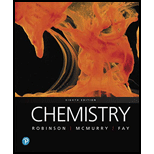
(a)
Interpretation:
The balanced equation for the overall reaction needs to be determined.
Concept introduction:
Balanced equation for a reaction is that equation in which the number of atoms of both the reactant and the product is same.
(b)
Interpretation:
Whether the mechanism is in consistent with the experimental rate law or not needs to be determined.
Concept introduction:
At equilibrium, rate of forward reaction is equal to the rate of reverse reaction.
In the mechanism, the second step is the slow step. Hence, it is the rate determining step. From the first step of the mechanism, one mole of
(c)
Interpretation:
The rate constant k needs to be related to the rate constants for the elementary reactions.
Concept introduction:
The rate constant in
Want to see the full answer?
Check out a sample textbook solution
Chapter 14 Solutions
EBK CHEMISTRY
- The Raschig reaction produces the industrially important reducing agent hydrazine, N2H4, from ammonia, NH3, and hypochlorite ion, OCl−, in basic aqueous solution. A proposed mechanism is Step 1: Step 2: Step 3: What is the overall stoichiometric equation? Which step is rate-limiting? What reaction intermediates are involved? What rate law is predicted by this mechanism?arrow_forwardWrite a rate law for NO3(g) + O2(g) NO2(g) + O3(g) if measurements show the reaction is first order in nitrogen trioxide and second order in oxygen.arrow_forwardNitrogen monoxide is reduced by hydrogen to give nitrogen and water: 2 NO(g) + 2 H2(g) N2(g) + 2 H2O(g) One possible mechanism for this reaction involves the following reactions: 2 NO(g) N2O2(g) N2O2(g) + H2(g) N2O(g) + H2O(g) N2O(g) + H2(g) N2(g) + H2O(g) What is the molecularity of each of the three steps? What is the rate equation for the third step? Identify the intermediates in this reaction; how many different intermediates are there? Show that the sum of these elementary steps gives the equation for the overall reaction.arrow_forward
- At 573 K, gaseous NO2(g) decomposes, forming NO(g) and O2(g). If a vessel containing NO2(g) has an initial concentration of 1.9 102 mol/L, how long will it take for 75% of the NO2(g) to decompose? The decomposition of NO2(g) is second-order in the reactant and the rate constant for this reaction, at 573 K, is 1.1 L/mol s.arrow_forwardOzone, O3, in the Earths upper atmosphere decomposes according to the equation 2 O3(g) 3 O2(g) The mechanism of the reaction is thought to proceed through an initial fast, reversible step followed by a slow, second step. Step 1: Fast, reversible O3(g) O2(g) + O(g) Step 2: Slow O3(g) + O(g) 2 O2(g) (a) Which of the steps is rate-determining? (b) Write the rate equation for the rate-determining steparrow_forwardOne possible mechanism for the decomposition of nitryl chloride, NO2CI, is What is the overall reaction? What rate law would be derived from this mechanism? What effect does increasing the concentration of the product NO2 have on the reaction rate?arrow_forward
- Define stability from both a kinetic and thermodynamic perspective. Give examples to show the differences in these concepts.arrow_forwardThe decomposition of iodoethane in the gas phase proceeds according to the following equation: C2H5I(g)C2H4(g)+HI(g) At 660. K, k = 7.2 104 sl; at 720. K, k = 1.7 102 sl. What is the value of the rate constant for this first-order decomposition at 325C? If the initial pressure of iodoethane is 894 torr at 245C, what is the pressure of iodoethane after three half-lives?arrow_forwardThe following rate constants were obtained in an experiment in which the decomposition of gaseous N2O; was studied as a function of temperature. The products were NO, and NO,. Temperature (K) 3.5 x 10_i 298 2.2 x 10"4 308 6.8 X IO-4 318 3.1 x 10 1 328 Determine Etfor this reaction in kj/mol.arrow_forward
- The decomposition of XY is second order in XY and has a rate constant of 7.41 × 10−3 L·mol−1·s−1 at a certain temperature, the half-life for this reaction at an initial concentration of 0.101 mol·L−1 1336. A) If the initial concentration of XY is 0.225 mol·L−1, how long will it take for the concentration to decrease to 6.95 × 10−2 mol·L−1 ?, B) If the initial concentration of XY is 0.080 mol·L−1, what is the concentration of XY after 75 s ?arrow_forwardAssume that the formation of nitrogen dioxide: 2NO(g) + O2(g) 2NO2(g) is an elementary reaction. (a) Write the rate law for this reaction. (b) A sample of air at a certain temperature is contaminated with 2.0 ppm of NO by volume. Under these conditions, can the rate law be simplified? If so, write the simplified rate law. (c) Under the conditions described in part (b), the half-life of the reaction has been estimated to be 6.4 × 103 min. What would the half-life be if the initial concentration of NO were 10 ppm?arrow_forwardConsider the reaction A + B ¡ C + D. Is each of the following statements true or false? (a) The rate law for the reaction must be Rate = k3A43B4. (b) If the reaction is an elementary reaction, the rate law is second order. (c) If the reaction is an elementary reaction, the rate law of the reverse reaction is first order. (d) The activation energy for the reverse reaction must be greater than that for the forward reaction.arrow_forward
 Chemistry & Chemical ReactivityChemistryISBN:9781337399074Author:John C. Kotz, Paul M. Treichel, John Townsend, David TreichelPublisher:Cengage Learning
Chemistry & Chemical ReactivityChemistryISBN:9781337399074Author:John C. Kotz, Paul M. Treichel, John Townsend, David TreichelPublisher:Cengage Learning ChemistryChemistryISBN:9781305957404Author:Steven S. Zumdahl, Susan A. Zumdahl, Donald J. DeCostePublisher:Cengage Learning
ChemistryChemistryISBN:9781305957404Author:Steven S. Zumdahl, Susan A. Zumdahl, Donald J. DeCostePublisher:Cengage Learning Chemistry: An Atoms First ApproachChemistryISBN:9781305079243Author:Steven S. Zumdahl, Susan A. ZumdahlPublisher:Cengage Learning
Chemistry: An Atoms First ApproachChemistryISBN:9781305079243Author:Steven S. Zumdahl, Susan A. ZumdahlPublisher:Cengage Learning
 Chemistry: Principles and PracticeChemistryISBN:9780534420123Author:Daniel L. Reger, Scott R. Goode, David W. Ball, Edward MercerPublisher:Cengage Learning
Chemistry: Principles and PracticeChemistryISBN:9780534420123Author:Daniel L. Reger, Scott R. Goode, David W. Ball, Edward MercerPublisher:Cengage Learning Chemistry & Chemical ReactivityChemistryISBN:9781133949640Author:John C. Kotz, Paul M. Treichel, John Townsend, David TreichelPublisher:Cengage Learning
Chemistry & Chemical ReactivityChemistryISBN:9781133949640Author:John C. Kotz, Paul M. Treichel, John Townsend, David TreichelPublisher:Cengage Learning





